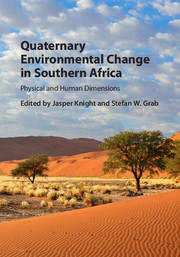Book contents
- Quaternary Environmental Change in Southern AfricaPhysical and Human Dimensions
- Quaternary Environmental Change in Southern Africa
- Copyright page
- Contents
- Contributors
- 1 The context of Quaternary environmental change in southern Africa
- 2 A brief geological history of southern Africa
- 3 A continental-scale perspective on landscape evolution in southern Africa during the Cenozoic
- 4 Hominin origins and evolution during the Neogene
- 5 Hominin evolution in Africa during the Quaternary
- 6 Quaternary environmental change on the southern African coastal plain
- 7 Dating the southern African landscape
- 8 Glacial and periglacial geomorphology
- 9 Colluvial deposits and slope instability
- 10 Desert dune environments
- 11 Changes in fluvial systems during the Quaternary
- 12 Wetlands in southern Africa
- 13 Sandy coasts
- 14 Environmental change during the Pleistocene and Holocene: Estuaries and lagoons of southern Africa
- 15 Soils and duricrusts
- 16 Karstic systems
- 17 Terrestrial ecosystem changes in the late Quaternary
- 18 Faunal evidence for mid- and late Quaternary environmental change in southern Africa
- 19 Pollen, charcoal and plant macrofossil evidence of Neogene and Quaternary environments in southern Africa
- 20 Minerogenic microfossil records of Quaternary environmental change in southern Africa
- 21 Development of the archaeological record in southern Africa during the Earlier Stone Age
- 22 Development of the archaeological record during the Middle Stone Age of South Africa
- 23 Later Stone Age hunter-gatherers and herders
- 24 Southernmost Africans, archaeology and the environment during the Holocene
- 25 Landscape–climate–human relations in the Quaternary of southern Africa
- Index
- References
11 - Changes in fluvial systems during the Quaternary
Published online by Cambridge University Press: 05 June 2016
- Quaternary Environmental Change in Southern AfricaPhysical and Human Dimensions
- Quaternary Environmental Change in Southern Africa
- Copyright page
- Contents
- Contributors
- 1 The context of Quaternary environmental change in southern Africa
- 2 A brief geological history of southern Africa
- 3 A continental-scale perspective on landscape evolution in southern Africa during the Cenozoic
- 4 Hominin origins and evolution during the Neogene
- 5 Hominin evolution in Africa during the Quaternary
- 6 Quaternary environmental change on the southern African coastal plain
- 7 Dating the southern African landscape
- 8 Glacial and periglacial geomorphology
- 9 Colluvial deposits and slope instability
- 10 Desert dune environments
- 11 Changes in fluvial systems during the Quaternary
- 12 Wetlands in southern Africa
- 13 Sandy coasts
- 14 Environmental change during the Pleistocene and Holocene: Estuaries and lagoons of southern Africa
- 15 Soils and duricrusts
- 16 Karstic systems
- 17 Terrestrial ecosystem changes in the late Quaternary
- 18 Faunal evidence for mid- and late Quaternary environmental change in southern Africa
- 19 Pollen, charcoal and plant macrofossil evidence of Neogene and Quaternary environments in southern Africa
- 20 Minerogenic microfossil records of Quaternary environmental change in southern Africa
- 21 Development of the archaeological record in southern Africa during the Earlier Stone Age
- 22 Development of the archaeological record during the Middle Stone Age of South Africa
- 23 Later Stone Age hunter-gatherers and herders
- 24 Southernmost Africans, archaeology and the environment during the Holocene
- 25 Landscape–climate–human relations in the Quaternary of southern Africa
- Index
- References
Summary
Despite their potential importance, southern Africa’s fluvial systems have yet to be fully exploited as archives of Quaternary palaeoenvironmental changes. This chapter outlines the regional environmental setting, and reviews the nature and drivers of southern African fluvial system responses, focusing mainly on examples where a secure geochronology exists. A key message is the need for recognition of diversity in the nature and drivers of Quaternary fluvial system change. Across the subcontinent, physiographic, tectonic, geological, climatic, vegetative – and more recently, anthropogenic – factors have combined in various ways to produce a variety of fluvial system responses that may incorporate aspects of channel lateral migration, avulsion, aggradation and/or incision. Depending on factors such as catchment scale and geomorphic setting, different fluvial systems exhibit differing sensitivities to natural and anthropogenic drivers, in turn influencing the production and preservation of fluvial sedimentary archives.
- Type
- Chapter
- Information
- Quaternary Environmental Change in Southern AfricaPhysical and Human Dimensions, pp. 170 - 187Publisher: Cambridge University PressPrint publication year: 2016
References
- 5
- Cited by

